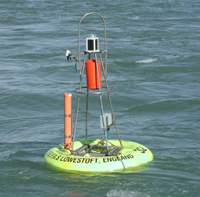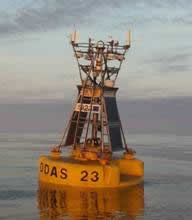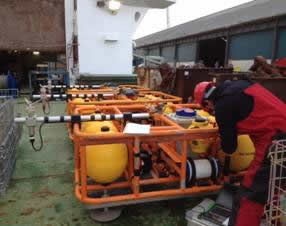More Candyfloss please
One of the targets for this exercise is a site called the Candyfloss Array. It is where an array of moored instruments is recording physical, chemical and biological properties 145 miles (235km) off the Cornish coast in the Celtic Sea.
 After reaching the site, travelling at 10 miles a day, the gliders have been circling the array taking similar measurements. These measurements will be compared later to evaluate the vehicles capacity to gather this information, and to fill in a few gaps with extra data.
After reaching the site, travelling at 10 miles a day, the gliders have been circling the array taking similar measurements. These measurements will be compared later to evaluate the vehicles capacity to gather this information, and to fill in a few gaps with extra data.
The Candyfloss array was put in place in March 2014 to understand how shelf seas work and connect with the open ocean and atmosphere. Candyfloss is short for Carbon And Nutrient DYnamics and Fluxes Over Shelf Systems. This research is a collaboration between the Met Office, Cefas (the Centre for Environment, Fisheries and Aquaculture Science) and NOC. The Candyfloss array includes a Cefas Smartbuoy that is measuring temperature, salinity, oxygen, nutrients and chlorophyll, and an ODAS Buoy owned and operated by the Met Office that is measuring wind speed and direction, air temperature and humidity. There is also a frame on the seafloor that measures current strength and direction.
 Shelf seas are the shallow seas that surround our coastlines. They are usually less than 200 metres (650ft) deep and are the boundary between the land and the deep ocean. Shelf seas are hugely important to the economy and benefit our lives in many ways. Although only about 5% of the global ocean surface area, shelf seas provide 90% of the global fish catch. They also play an important role in removing carbon dioxide from the atmosphere, transporting it to the deep ocean and potentially locking it away for long periods of time. Scientists are very interested to find out how this happens and to measure the process.
Shelf seas are the shallow seas that surround our coastlines. They are usually less than 200 metres (650ft) deep and are the boundary between the land and the deep ocean. Shelf seas are hugely important to the economy and benefit our lives in many ways. Although only about 5% of the global ocean surface area, shelf seas provide 90% of the global fish catch. They also play an important role in removing carbon dioxide from the atmosphere, transporting it to the deep ocean and potentially locking it away for long periods of time. Scientists are very interested to find out how this happens and to measure the process.
 The array will be in place for 18 months until August 2015 and is supporting another research initiative, the NERC Shelf Seas Biogeochemistry research programme. This research is looking at the processes that take place in shelf seas over a complete seasonal cycle from summer through to winter – both in the water and in the sediments on the seabed. Some of the data collected during this campaign will be contributing to this research programme.
The array will be in place for 18 months until August 2015 and is supporting another research initiative, the NERC Shelf Seas Biogeochemistry research programme. This research is looking at the processes that take place in shelf seas over a complete seasonal cycle from summer through to winter – both in the water and in the sediments on the seabed. Some of the data collected during this campaign will be contributing to this research programme.
The Candyfloss Array is measuring a range of air and water qualities:
- Temperature and salinity to see how much and how quickly the water heats up and cools down between the summer and winter
- The strength of tidal currents and winds that are able to mix the water and anything that is in it
- The amount of nutrients (nitrate, phosphate, silicate) in the water that are essential for plants – phytoplankton – to grow
- Indicators of growth and life – oxygen and chlorophyll
- The clarity of the water – sediments being washed around in the water that make it murky
- How much light penetrates beneath the sea surface
- The conditions in the atmosphere – air temperature, humidity, wind speed and direction
